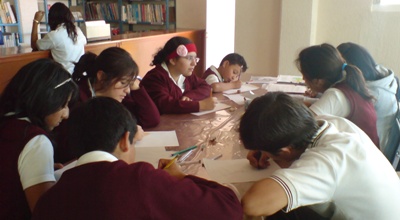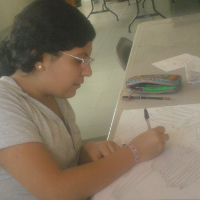Pupils at Cookridge Primary School in Leeds, England, asked students at Colegio Esperanza in Tlaxcala, Mexico, about the double-headed serpent.

This serpent mosaic was created in Aztec Mexico. It may have been worn or carried during religious ceremonies. Snakes were sacred to the Aztecs as they were the symbol of the feathered serpent god, Quetzalcoatl.
Why is the serpent important or precious to you?

Mexico has a big territory, in it different cultures developed, the most well-known were Aztec, Teotihuacan, Zapoteca, Olmec, Maya.
The serpent is an element that is present at the amazing monuments that form, nowadays, lost cities.
The serpent represented the gods and the most important for Aztec people was Quetzalcoatl. The serpent is part of our Mexican coat of arms.
Do you know why the serpent was picked by the Aztecs?
 The legend says that the serpent is associated with several Mexica deities including Quetzalcoatl, feathered snake.
The legend says that the serpent is associated with several Mexica deities including Quetzalcoatl, feathered snake.
The ability of snakes to shed their skin each year, probably led to them being used to convey ideas concerning renewal and transformation.
The ability of many species to move freely between water, earth and the forest helped underline their symbolic role as intermediary between the different layers of the Cosmos, underworld, earth and sky.
On the other hand the serpent was a symbol of power and strength.
Does anyone in Mexico still believe in snakes as gods?
No, people don't believe in snakes as gods, but some of them believe that snakes announce good or bad luck.
Here are some examples: When a person is looking for [medicinal] plants in the mountain to heal someone and meets a snake that means that the ill person will die.
When someone dreams about snakes, people say that it means someone is gossiping or envies that person.
Finding a snake foreshadows legal problems or imprisonment.
Was mosaic used for any other objects?
 Yes, it was used in masks, shields, knives, discs, animal forms and little statues.
Yes, it was used in masks, shields, knives, discs, animal forms and little statues.
These pieces were sent to Tenochtitlan, the Aztec capital as tribute to adorn images of the gods, as well as priests and the nobility.
This picture shows a gold 'pectoral' with turquoise mosaic.
 Read more of our A History of the World stories
Read more of our A History of the World stories
How did they do that?
Cookridge Primary School in England and Colegio Esperanza in Mexico are twinning through the British Council's Connecting Classrooms programme.
Join BBC World Class and our partners will help your school twin with a school in another country.
Sign up for the newsletter for more ideas.
The BBC is not responsible for the content of external websites.